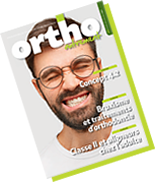BIBLIOGRAPHIE
Ortho Autrement n° 61
Avril – Mai – Juin 2025
« Prévalence du bruxisme et son incidence sur nos traitements orthodontiques » – pages 3 à 11 du magazine
1. Demjaha G, Kapusevska B, Pejkovska-Shahpaska B. Bruxism Unconscious Oral Habit in Everyday Life. Open
Access Maced J Med Sci. 2019 Mar 14;7(5):876-881.
2. Orthlieb JD, Duminil G. Le bruxisme, tout simplement. Paris: Information dentaire; 2015.
3. Lobbezoo F, Ahlberg J, Raphael KG, Wetselaar P, Glaros AG, Kato T, Santiago V, Winocur E, De Laat A, De
Leeuw R, Koyano K, Lavigne GJ, Svensson P, Manfredini D. International consensus on the assessment of
bruxism: Report of a work in progress. J Oral Rehabil. 2018;45(11):837-844.
4. Detarvernier E. Bruxisme et orthodontie [Thèse d’exercice]. Faculté d’Odontologie de Lyon; 2019.
5. Aguila C. Incidence du bruxisme dans la prise en charge implantaire [Thèse d’exercice]. Faculté d’Odontologie
de Marseille; 2021.
6. Johansson A, Omar R, Carlsson GE. Bruxism and prosthetic treatment: A critical review. J Prosthodont Res.
2011;55(3):127-36.
7. Manfredini D, Colonna A, Bracci A, Lobbezoo F. Bruxism: a summary of current knowledge on aetiology,
assessment and management. Oral Surg 2021;13:358–70.
8. Maluly M, Andersen ML, Dal-Fabbro C, Garbuio S, Bittencourt L, de Siqueira JT, Tufik S. Polysomnographic
study of the prevalence of sleep bruxism in a population sample. J Dent Res. 2013;92:S97-103.
9. Klasser G, Greene C, Lavigne G. Oral Appliances and the Management of Sleep Bruxism in Adults: A Century
of Clinical Applications and Search for Mechanisms. Int J Prosthodont. 2010;23(5):453-62.
10. Lavigne, G.J., et al., Bruxism physiology and pathology: an overview for clinicians. J Oral Rehabil.
2008;35(7):476-94.
11. Melo G, Duarte J, Pauletto P, Porporatti AL, Stuginski-Barbosa J, Winocur E, et al. Bruxism: An umbrella
review of systematic reviews. J Oral Rehabil. 2020; 46(7):666-90.
12. Więckiewicz M, Paradowska-Stolarz A, Wieckiewicz W. Psychosocial Aspects of Bruxism: The Most
Paramount Factor Influencing Teeth Grinding. Biomed Res Int. 2014;2014:1-7.
13. Restrepo C. Bruxism in children. In: Paesani DA, editor. Brux- ism: theory and practice. London:
Quintessence Publishing; 2010. p. 111–20.
14. Archbold KH, Pituch KJ, Panahi P, et al. Symptoms of sleep disturbances among children at two general
pediatric clinics. JPediatr 2002;140:97–102.
15. Naha ́s-Scocate ACR, Coelho FV, Almeida VC. Bruxism in children and transverse plane of occlusion: is there
a relationship or not? Dental Press J Orthod 2014;19:67–73.
16. Lobbezoo F, Naeije M. Bruxism is mainly regulated centrally, not peripherally. J Oral Rehabil.
2001;28(12):1085-91.
17. Lobbezoo F, Naeije M. Etiology of bruxism: morphological, pathophysiological and psychological factors. Ned
Tijdschr Tandheelkd. 2000;107(7):275-80.
18. Slavicek R, Sato S. Bruxism–a function of the masticatory organ to cope with stress. Wien Med Wochenschr.
2004;154(23-24):584-9.
19. de Baat C, Verhoeff M, Ahlberg J, Manfredini D, Winocur E, Zweers P, Rozema F, Vissink A, Lobbezoo F.
Medications and addictive substances potentially inducing or attenuating sleep bruxism and/or awake bruxism.
J Oral Rehabil. 2022 Mar;48(3):343-354.
20. Lobbezoo F, Ahlberg J, Glaros AG, Kato T, Koyano K, Lavigne GJ, et al. Bruxism defined and graded: an
international consensus. J Oral Rehabil. 2013;40(1):2-4.


